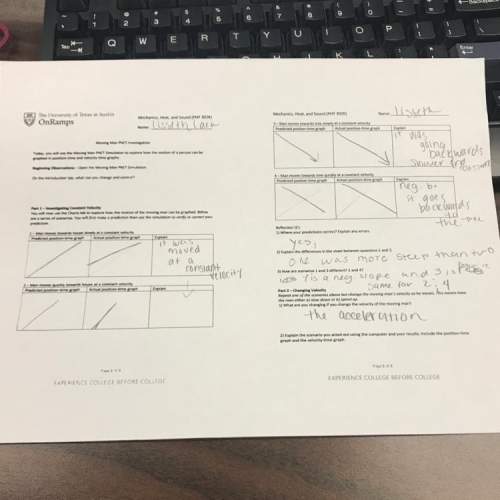
Physics, 27.08.2019 19:30 alizeleach0123
Ignore my answers but someone give me something to put on here using these graphs i made using a moving man or whatever on the right bottom it asks "explain the scenario you acted out using the computer and your results. include the position time graph and the velocity time graph" literally all i did was let the dude move and a constant slow velocity of 1 and a constant quick velocity of 10


Answers: 1


Another question on Physics

Physics, 22.06.2019 01:30
Ablock of mass 1.5 kg slides down an inclined plane that has an angle of 15. if the inclined plane has no friction and the block starts at a height of 3 m, how much kinetic energy does the block have when it reaches the bottom? acceleration due to gravity is g = 9.8 m/s2. a. 6.8 j b. 50.9 j c. 0 j d. 44.1 j
Answers: 1

Physics, 22.06.2019 15:00
You hang a book bag on a spring scale and place the bag on a platform scale so that the platform scale reads 23.7n and the spring scale reads 13.8n. what is the magnitude of the force that earth exerts on the bag?
Answers: 1

Physics, 23.06.2019 02:30
Ball bearings are made by letting spherical drops of molten metal fall inside a talll tower-called a shot tower- and solidify as they fall. a-if a bearing needs 4.0 s to solidify enough for impact, how high must the tower be? b- what is the bearing's impact velocity?
Answers: 3

Physics, 23.06.2019 08:30
Apoint charge +q is at the origin. a spherical gaussian surface centered at the origin encloses +q. so does a cubical surface centered at the origin and with edges parallel to the axes. select "true" or "false" for each statement below. the electric flux through the spherical surface is greater than that through the cubical surface. suppose (for this statement only), that q is moved from the origin but is still within both the surfaces. the flux through both surfaces remains unchanged. the area vector and the e-field vector point in the same direction for all points on the spherical surface. the e-field at all points on the spherical surface is equal due to spherical symmetry. the flux through the spherical gaussian surface is independent of its radius.
Answers: 3
You know the right answer?
Ignore my answers but someone give me something to put on here using these graphs i made using a mov...
Questions

Mathematics, 27.10.2020 18:40


Mathematics, 27.10.2020 18:40

Mathematics, 27.10.2020 18:40

Mathematics, 27.10.2020 18:40

Mathematics, 27.10.2020 18:40


Mathematics, 27.10.2020 18:40

Health, 27.10.2020 18:40



Mathematics, 27.10.2020 18:40

History, 27.10.2020 18:40

Health, 27.10.2020 18:40

Geography, 27.10.2020 18:40

Chemistry, 27.10.2020 18:40


Biology, 27.10.2020 18:40





